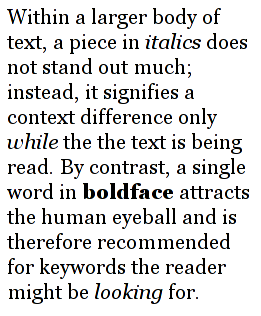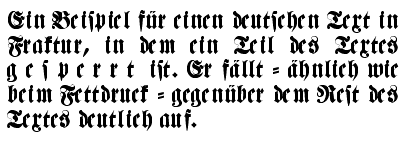(Redirected from
Bold typeface)
- Bold redirects here. For uses of Bold, see Bold (disambiguation).
In typography, emphasis usually refers to means of stressing parts of a text by using letters in a different style from the rest of the text to make them stand out from the main text body.
Methods and uses of emphasis
The human eye is very receptive to differences in brightness within a text body. One can therefore differentiate between types of emphasis according to whether the emphasis changes the "blackness" of text.
 Fig. 1: Emphasis example
Fig. 1: Emphasis example
A means of emphasis that does not have much effect on "blackness" is printing in italics, where the vertical orientation of all letters is tilted to the right. With this technique, words can be highlighted without making them "stick out" much from the rest of the text (inconspicuous stressing). Traditionally, this is used for marking passages that have a different context, such as words from foreign languages, book titles, etc.
By contrast, boldface makes text darker than the surrounding text. With this technique, the emphasized text strongly stands out from the rest; it should therefore be used to highlight certain keywords that are important to the subject of the text, for easy visual scanning of text. For example, printed dictionaries often use boldface for their keywords; Wikipedia follows this convention when the name of each article is marked at the top in bold.
Emphasis in design
With both italics and boldface, the emphasis is correctly achieved by temporarily replacing the current typeface. Professional typographic systems (which include most modern computers) would therefore not simply tilt letters to the right to achieve italics (that is instead referred to as slanting) or print them darker for boldface, but instead use entirely different typefaces that achieve the effect. As can be seen in Fig. 1, the "w" letter, for example, looks quite different in italics compared to the regular typeface.
As a result, typefaces therefore have to be supplied at least fourfold (with computer systems, usually as four font files): as regular, italics, bold, and both bold and italics to provide for all combinations. Professional typefaces sometimes offer even more variations for popular fonts, with varying degrees of blackness. Only if such fonts are not available should the effect of italics or boldface be imitated by tilting or blacking the original font.
Alternative methods for emphasis
 Fig. 2: Fraktur emphasis example
Fig. 2: Fraktur emphasis example
In Germany, a different means of emphasis was previously used. To achieve a variance in blackness, instead of making the letters darker, one would increase the spacing between them. This resulted in an effect reverse to boldface: the emphasized text becomes lighter than its environment. This was referred to as sperren in German, which could here be translated as "spacing out". While sperren normally means "to lock (out)", this particular meaning was figurative : with the older method of typesetting with letters of lead, the spacing would be achieved by inserting additional non-printing slices of metal between the types.
The example text reads: "An example of German text in Fraktur in which a portion of the text is spaced out. It is noticed, as with boldface, clearly as opposed to the rest of the text.
The reason for this particular German typographic convention can be seen in the traditional use of Fraktur typefaces, for which boldface was not feasible, since the letters were very dark in their standard format. The Fraktur typeface was officially abolished in 1942 by Nazi Germany, and after that, its use quickly diminished. As a result, the use of spacing as a means of emphasis in printed materials quickly became obsolete. However, spacing is sometimes still used as a means of emphasis in typographic media where only one typeset is available, e.g. in typewritten communication or on text-only computer terminals.
Last updated: 04-25-2005 03:06:01